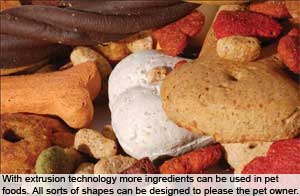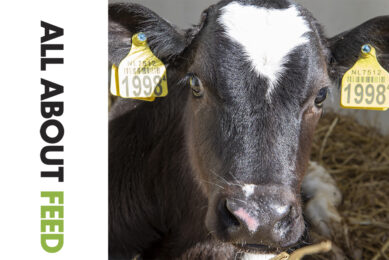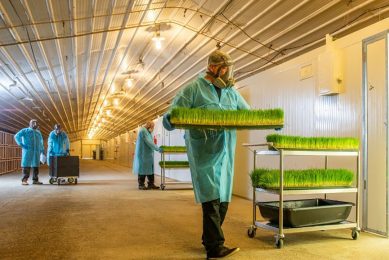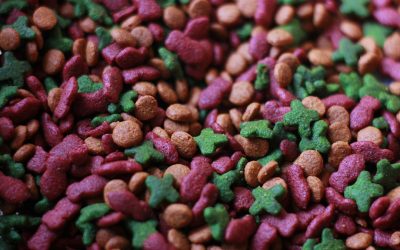Short supply puts pressure on gourmet chicken pet food

Fifty years ago pets were fed table scraps. Today, due to marketing and ‘feel good factors’, our dogs and cats actually receive almost the same diet, but in a more sophisticated and balanced manner. Rising competition from the aquafeed sector, together with increased demand from the pet food sector, have put pressure on the supply of poultry by-product meal as a feed ingredient.
By Bill Dieterichs *
Extruded pet foods have changed over the past 50 years, but not as much as the attitude of the pet owner about their pet and the foods they feed them. Some 50 years ago in the United States, when extruded pet food sales were just getting started, the ingredient mix was simple, comprised mostly of grains, soybean meal, meat and bone meal, a little poultry by-product meal, gluten meal, animal fats, and a vitamin and mineral premix.
In the mid-1960s pets were mostly fed canned pet foods and table scraps. About this time it was noted that extruding these livestock feed ingredients helped increase the digestibility of this basic grain and protein mixture for dogs and cats. As the companies made more dry extruded pet foods they began to market those products through the grocery markets, hence the words ‘pet food’ rather than ‘pet feed’. The rations were “complete and balanced” for both dogs and cats. Consumers quickly discovered the convenience of feeding a dry pet food out of a bag or box rather than the “messy” canned product. Pets were also becoming more a part of the family than ever before, and the consumer wanted to pamper their pets with a nutritionally balanced pet food rather than table scraps. In fact, one pet food maker told the consumer that their dog food was so well balanced nutritionally that all the pet owner had to do to the dog food was add love.
Chicken popularity
As the years progressed pet food owners either demanded, or were convinced by marketing arms of the pet food companies, that what was good for the human pet owner was good for the pet. As the populace grew and learned more about their own nutrition and healthy well-being, the popularity of chicken grew. More and more chicken was added to the pet food ration either through chicken by-product meal, or by adding raw chicken to the ration before extrusion. Chicken was considered “up-scale” and began replacing beef.
Then came lamb, at least in the US, as it was an ingredient already popular in Europe. Interestingly, the US per capita consumption of lamb is just below 500 g, yet when it was introduced into the pet food diet in the 1980s it became a big selling favourite. The main reason for this growth was that the US dog population was apparently not allergic to lamb and many dogs fed a diet containing lamb found their itchy dry skin gone and the coat shiny, making the people buying the pet foods very happy. Additionally, pet owners felt it added some variety to their pet’s diet.
Flavours and health consciousness
As pet food buyers became more aware of what was going into pet foods and the idea that ‘what is good for me has to be good for my pet’ continued to grow, new flavours and health benefit ingredients became the rage. Today, when a person walks through the pet food aisles in stores it is not uncommon at all to see words like, whole ground grains (as if they hadn’t been all along), natural, organic, beef pot roast flavoured, Tuscan flavoured, anti-oxidants added, such as cranberries, and blueberries added for heart health and so on and so on. Specialty fish meals are also being sought to add a unique flavour to cat food.
It is interesting to note, however, that base ingredients for pet foods have not changed much from 50 years ago with the exception of the addition of rice to the grains list, and the switch from meat and bone meal to pet food grade poultry by-product meal in many of the pet foods. It is estimated that 95% of pets in the US are fed a processed food, and Western Europe is not far behind leaving little opportunity for additional pet food growth in those areas. However, according to Euro Monitor, a company that conducts industry surveys, at the 2010 International Poultry Exposition the countries that will see the greatest growth in pet food sales are found in Eastern Europe, Russia, China, India and Brazil, as the middle class in those countries expands.
Each of these areas for the most part is able to grow their own grains and proteins to use in the pet foods. The one ingredient exception to that statement, I believe, is a Pet Food Grade Poultry By-Product Meal (PFG PBM). China and India, for the most part, use far more of the entire chicken for food than does the US or Brazil. An example is that China imports nearly all of the chicken paws grown in the US and Brazil, which in effect reduced the amount of PFG PBM produced by some 7% when China began importing paws.
Because of the restriction in Europe of ruminant MBM in feed and pet food rations, the EU’s use of PFG PBM is expanding and current supplies are no longer keeping up with demand. EU sources indicate that they would not be surprised to see the Europeans turn to the US or Brazil for PFG PBM supplies. In the US, the current supply of PFG PBM is nearly all used in pet foods and is now finding favour in aquaculture rations as a replacement for fish meal.
Poultry for fish
As the production of farmed fish and shellfish increases worldwide, especially in China, fish meal supplies have not been sufficient to cover the demand needed for use in aquaculture feeds. Demand for farm raised fish and shellfish is showing no signs of subsiding as today some have estimated that 50% of the fish and shellfish sold in the world is “farm” raised and that output from aquaculture is expected to increase versus wild caught fish and shellfish. As aquaculture demand increased and the fish meal supplies and prices became more erratic, the feed mixers have reached out more and more to the PFG PBM because of its constant supply and relatively steady price when compared to fish meal. Now the supplies of PFG PBM are not keeping up with demand and prices have increased sharply as pet food and aquaculture buyers now vie for the supplies. With the higher prices some pet food buyers, particularly in the US, are now threatening to switch to pork meal.
This tightness of PFG PBM supply has been caused by growing demand from pet food manufacturers and exacerbated by the aquaculture demand because of the lack of adequate fish meal supplies. The supply of PFG PBM is very inelastic, in other words more money doesn’t bring more supply, and the US producers are at maximum production given the offal they have to render. Having been in and around the pet food industry for 40 years as a pet food ingredient buyer, the supply tightness situation in PFG PBM, a major pet food ingredient, is the first I can remember.
Certainly time and probably price will tell how serious this tightness in PFG PBM is for pet food producers. But, this is one of those things that a pet food ingredient buyer should keep an eye on as they perform their duties.
*W.R. “Bill” Dieterichs has over 35 years of experience as a protein and fat buyer for livestock feed and pet food for Ralston Purina. He has an in-depth understanding of the poultry, livestock and fish processing and rendering industries in the US, Canada, Australia and New Zealand. During his tenure, he was also responsible for purchasing and advising operations in Europe and South America on animal protein meal purchases. Most of Bill’s Ralston Purina time was spent in purchasing ingredients for the pet food division, including variety meats for canned and dry pet foods and the poultry by-product meal, which became the major meat protein in Ralston Purina’s pet foods. Today, Bill is responsible for price discovery, market analysis and commentary for The Jacobsen Feed Bulletin – Animal and the Fats & Oils Bulletin – Animal.
Source: AllAboutFeed nr 2 vol1, 2010











